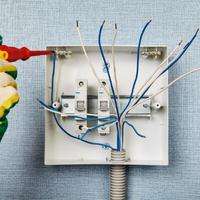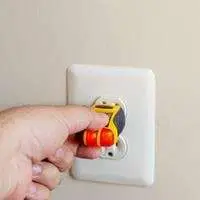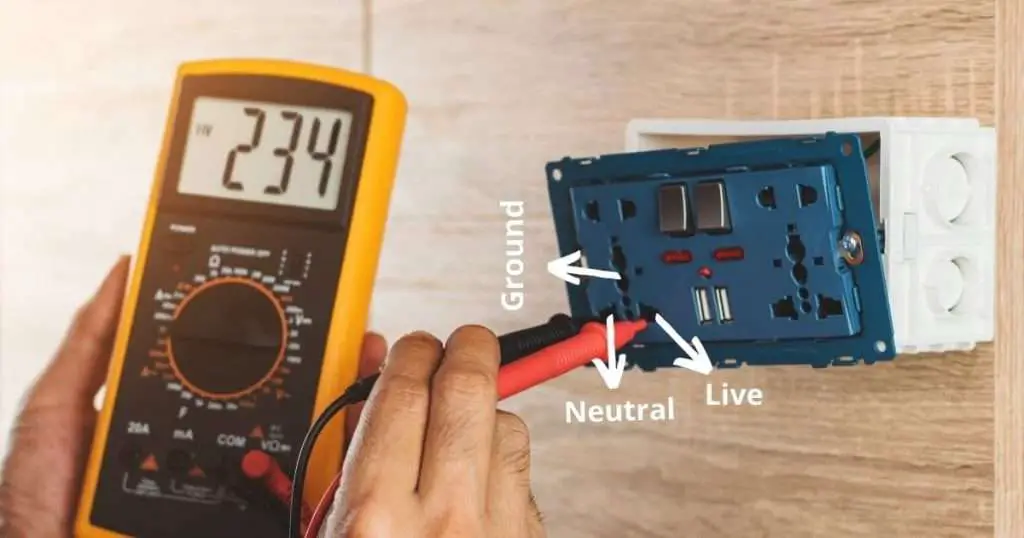While setting up a new outlet or electrical connection in your room, you may be unaware of how to identify neutral wire with a multimeter.
Identifying a neutral wire as others for a secure connection is essential. Testing a neutral wire can also prevent electrical risks such as an open neutral (disconnected or loose neutral wire).
In this post, you’ll learn how to identify a neutral wire and troubleshoot an open neutral in a circuit using a multimeter.
Table of Contents
ToggleHow to Identify a Neutral Wire with a multimeter?
By measuring the voltage between the ground wire and the remaining wires, we can identify neutral and live wires with the voltage difference.
At first, I didn’t know the live or neutral wire and identified them from different multimeter readings.
The neutral wire should have minimum voltage when tested with the ground wire, while the live wire will read 120 or 240 volts when tested along the ground wire.
Set the multimeter to a high AC voltage setting to test the neutral wire. Place one probe on the ground wire or any grounded object and the other probe on the remaining wires one by one.
Here is a step-by-step guide to identifying a neutral and hot wire using a multimeter
Safety precautions
As we have to work with high voltage carrying wires to identify a neutral wire, we must wear rubber or nitrile-insulated gloves to prevent electrical hazards if we accidentally touch the bare end of cables.
Identify the ground wire.
As we have to detect neutral wire with the voltage difference from the ground wire, it’s essential to identify the ground wire first.
- In a three-pin socket of an outlet, a ground wire is usually connected to a top or bottom single hole.
- However, if your home wiring is done with a standard electrical color code, green or yellow or green with a yellow strip is used as a ground wire.
Set the Multimeter to AC Voltage
- Insert the black probe into the COM port and the red probe into the VΩmA port on the multimeter.
- As home appliances run over AC voltage, we must select the AC voltage setting on the multimeter, denoted by V∼.
- Set a higher AC voltage range on the dial, as we have to measure high voltage current.
Connect probes to wires
- As we have identified the ground wire in the first step, put one probe over its bare end.
- Touch the other probe to the remaining wires one by one. Don’t let the probes and the wire collide with each other.
Evaluate results
Connect a probe to the ground wire and the other probe to the remaining wires.
A wire that gives around zero voltage with ground wire is the neutral wire, as neutral doesn’t supply current instead, it provides a path (loop) for the current back to the power source.
The other wire will show around 120 or 240 volts on the multimeter, which means it’s a live wire.
How to find an open neutral
When the neutral wire in an outlet is not connected or loose from the breaker or the outlet, an open neutral may cause a drop or increase of voltage and end up burning your appliance, as the current return path is defective.
We use a receptacle tester and a multimeter to find an open neutral and troubleshoot this problem.
Step 1: Find an open neutral in an outlet.
- We use a receptacle tester to configure if a circuit has an open neutral. Insert the tester in the outlet, and if there is an
 open neutral, only the rightmost bulb will glow, indicating that only the live wire is connected and the neutral is missing.
open neutral, only the rightmost bulb will glow, indicating that only the live wire is connected and the neutral is missing. - You can find the sign of open neutral on the receptacle tester and compare them with glowing bulbs.
- Also, measure voltage between live and neutral wire terminals of an outlet with a multimeter. If the reading exceeds the maximum supply (120 or 240 volts), there is a wiring issue.
- For example, your home electrical distribution system provides 120 V to an outlet, and your multimeter reads around 100 volts between the neutral and live wires.
A loose neutral wire connection is somewhere in the circuit, hindering maximum current flow.
Step 2: Test other outlets to find open neutral.
- You should know the wiring direction and from which outlet wires are going to the other outlet in your room. Insert the tester inside every outlet and check if additional outlets have an open neutral.
- Use a multimeter to check continuity in the neutral wire, showing open neutral signs on the receptacle tester from one outlet to the other.
If you cannot identify neutral wire, follow a quick guide at the start of this post.
Step 3: Troubleshoot
If the multimeter shows discontinuity between the neutral wire of two outlets, there is some issue with the neutral wire between the two tested points.
Inspect and find a neutral wire that is disconnected, loose or broken, and connect them to its required terminal or socket.
How do I know if I have a neutral wire?
- Color of Wire: Using a multimeter or outlet tester, you can detect a neutral wire by color. Open the receptacle and check if a blue or white wire is connected to the socket, usually used as neutral.
- Test continuity: Use a multimeter and test for continuity between a receptacle’s left and right holes, as one is a neutral wire terminal. If the multimeter show connectivity, then the neutral wire is available.
- Measure voltage: You can figure out a neutral wire by doing a voltage test between the ground and the other wires. From ground to neutral, the multimeter should read zero to a few volts and high voltage, such as 120 or 240 volts, between ground and live wire.
How to check if a neutral wire is working
Using a multimeter, you can detect whether the neutral wire is working.
- Set the multimeter to AC voltage. Connect one probe to the live wire, and the other to the neutral and ground wires, and measure both readings.
- If the neutral wire works well, you will get the same readings from live to neutral and live to ground.
- If the multimeter reads quite a low voltage between live-neutral and live-ground, there is a problem with neutral wiring.
- Insert an outlet tester in the socket or receptacle, detect the glowing lights and compare it with the guide labeled on the tester. If the leftmost light glows, then neutral is working; otherwise, it’s unavailable.
What is the color of the neutral wire?
Typically, neutral is blue or white, live is brown or black, and the ground is green, yellow, or a bare wire.
How to test neutral wire without a multimeter
You can also check if the neutral wire is installed or properly working without a multimeter. Get a bulb socket and insert its wire inside the live and neutral terminal hole.
If the bulb glows, both wires are working. Otherwise, remove the receptacle cover and identify which wire is malfunctioning.
In the same way, you can check if a ground connection is available. Connect the bulb socket wires to the ground and live terminal of an outlet.
In a grounded circuit, the bulb will glow. Otherwise, it won’t, indicating an unavailable ground wire.
Why is neutral wire required?
A neutral wire is an essential circuit component that carries current from the circuit to the ground wire and back to the main power supply.
A neutral wire is required to provide a continuous path as the current moves in the loop. Current flows back from a device to the outlet and then to the power supply via a neutral wire.
A live wire carries current from the main power source to the outlet to run appliances. A neutral wire gets current back from the device to the power source to complete the circuit(loop).
A disconnected or damaged neutral wire may cause an imbalance in voltage across the electrical system and can burn your appliances.
As in the US, the power supply is cut into two live phases, each carrying 120 V, with a single neutral wire. If there is an open neutral, one outlet gets extra voltage, and the other may face depletion. In such cases, lights from one room or outlet may dim, and others are pretty bright.
Conclusion
A neutral wire should be necessarily installed in an electrical system to function a circuit properly. You can make a secure connection in an outlet by identifying a neutral wire.
You can use a multimeter to find a neutral wire or an outlet detector to find an open neutral. This guide will help you identify a neutral wire and fix an open neutral in your room connections.
Related Guides:





